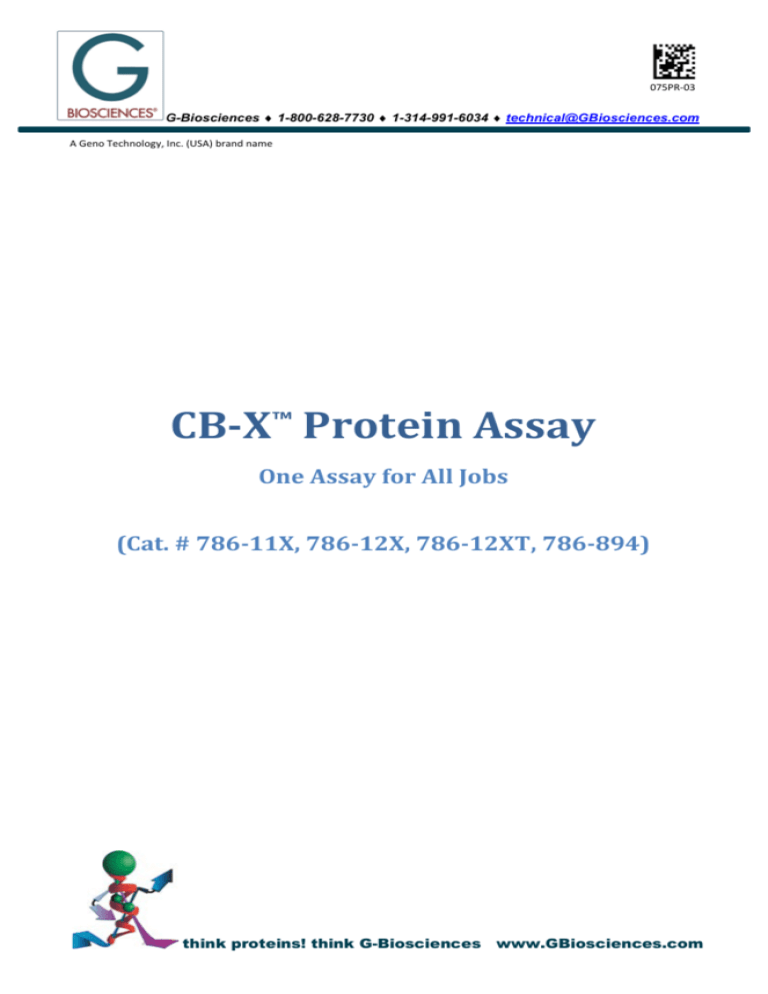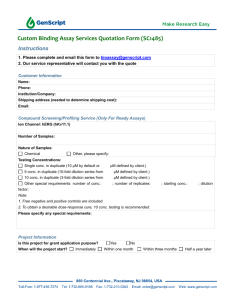CB-X™ Protein Assay One Assay for All Jobs (Cat. # 786
advertisement

075PR-03 G-Biosciences ♦ 1-800-628-7730 ♦ 1-314-991-6034 ♦ technical@GBiosciences.com A Geno Technology, Inc. (USA) brand name CB-X™ Protein Assay One Assay for All Jobs (Cat. # 786-11X, 786-12X, 786-12XT, 786-894) think proteins! think G-Biosciences www.GBiosciences.com INTRODUCTION ................................................................................................................. 3 ITEM(S) SUPPLIED .............................................................................................................. 5 STORAGE CONDITION ........................................................................................................ 5 ITEMS NEEDED AND NOT SUPPLIED WITH THIS KIT .......................................................... 5 PREPARATIONS BEFORE USE ............................................................................................. 5 PROTOCOL 1: FOR SIMPLE, UNCOMPLICATED AQUEOUS SAMPLES ................................. 6 PROTOCOL 2: FOR INTERFERING AGENT REMOVAL (SAMPLE CLEAN UP) & PROTEIN ESTIMATION ...................................................................................................................... 6 PROTOCOL OPTIMIZATION ................................................................................................ 7 RELATED PRODUCTS .......................................................................................................... 7 Page 2 of 8 INTRODUCTION Protein assays are routinely used in many research fields to estimate proteins in a vast array of buffers and conditions. A major problem for researchers is to select a protein assay from the vast selection on the market that is compatible with their protein ™ sample. CB-X Protein Assay eliminates this problem as it is designed to be compatible with all commonly used buffers and conditions in protein isolation, storage and assays. ™ For protein samples in simple, uncomplicated aqueous buffers CB-X is a highly ™ sensitive, single reagent assay that can be performed in 5 minutes. CB-X Protein Assay uses a protein dye that is an improvement on the Bradford Coomassie dye reagent. ™ For complicated protein samples CB-X Protein Assay is supplied with reagents to clean up the samples and remove all reagents and chemicals that interfere with accurate protein estimation. These reagents include detergents, chaotropes, reducing agents, alkylating agents, sugars, high salt concentrations, buffering agents and chelating agents (Table 1). The clean up stage and subsequent protein assay is performed in a single tube to ensure no protein loss and to maintain the accuracy of the assay. DETERGENTS REDUCING AGENTS ® Brij 35 2% 2-mercaptoethanol 1M CHAPS 2% DTT 1M CHAPSO 2% CHAOTROPES ® Nonidet P-40 2% Guanidine.HCl 6M SDS 2% Urea 6M ® 2% Triton X-100 ® Tween 20 2% Deoxycholate 0.1% SALTS Ammonium sulfate 1M MISCELLANEOUS SUGARS EDTA 0.1M Glucose 1M HEPES 0.1M Sucrose 25% MES 0.1M Table 1: CB-X™ Protein Assay is compatible with many interfering agents ™ Figure 1 demonstrates the efficiency of the CB-X Protein Assay. If interfering agents are present, such as detergents, or if an artifact results are produced then the protein samples are treated with the clean up reagents and the protein is then assayed generating a linear response. Page 3 of 8 Figure 1: CB-X™ Protein Assay. Inhibitory effects of detergents on protein assays are abolished with CB-X™. Protein solutions containing 1% Triton® X-100 or 1% SDS were assayed using a standard Coomassie dye protein assay. The same protein samples with 1% Triton® X100 or 1% SDS were assayed using CB-X™ protein assay. A linear response to increasing protein concentration was visualized, indicating no interference by the detergents. ™ ™ CB-X Protein Assay is supplied with a lot specific CB-X Tables. These allow researchers to perform single protein clean ups, subsequent assays and then look up their ™ ™ absorbance in the CB-X Table to find the protein concentration. The CB-X Table eliminates the need for multiple protein standards and saves considerable time and ™ effort. The CB-X Table is prepared with a complex protein mixture that compares well with proteins from mammalian, plant, bacteria and yeast sources. An optional set of bovine serum albumin standards or non-animal protein standards are supplied with Cat. ™ # 786-12X or 786-894 respectively for generating curves when using CB-X Assay Dye alone or for researcher’s who prefer to generate their own standard curve or to ™ generate their own CB-X Table for their specific conditions. ™ The CB-X Protein Assay is reliable over the range of 0.5-50µg per assay. The regular size ™ kit contains enough CB-X Assay Dye for 500 protein assays and enough clean up reagents for 250 clean ups. (Patents Pending) Page 4 of 8 ITEM(S) SUPPLIED Cat. # 786-11X Cat. # 786-12X Cat. # 786-894 Cat. # 786-12XT ™ 2 x 125ml 2 x 125ml 2 x 125ml 10ml ™ 2 x 250ml 2 x 250ml 2 x 250ml 10ml ™ 15ml 15ml 15ml 1ml ™ 15ml 15ml 15ml 1ml - 5ml - - 5ml - 1 1 1 1 Description CB-X CB-X Assay Dye CB-X Solubilization Buffer-I CB-X Solubilization Buffer-II ™ CB-X Protein Standard [2mg/ml] Non-Animal Protein Standard [2mg/ml] ™ CB-X Table: Lot Specific - STORAGE CONDITION ™ The kit is shipped at ambient temperature. Upon arrival, store CB-X Assay Dye and ™ protein standard at 4°C and other kit components at room temperature. The CB-X reagent must be chilled to -20°C for optimal efficiency, for additional convenience the ™ CB-X reagent can be stored at -20°C. When stored and used properly this kit is good for 12 months. ITEMS NEEDED AND NOT SUPPLIED WITH THIS KIT • Centrifuge • Assay tubes (G-Biosciences Cat # 786-008) • Disposable polystyrène cuvettes (G-Biosciences Cat # 786-009) PREPARATIONS BEFORE USE ™ 1. Chill CB-X at -20°C. ™ NOTE: CB-X can be stored at -20°C for prolonged storage and additional convenience. ™ 2. Prior to use, mix CB-X Assay Dye by gently inverting the bottle several times. DO NOT SHAKE THE BOTTLE. Page 5 of 8 PROTOCOL 1: FOR SIMPLE, UNCOMPLICATED AQUEOUS SAMPLES 1. Dilute the supplied protein standards in the same buffer as your protein samples. We recommend duplicates of 5-6 dilutions within the range of 0.1-1.0mg/ml. 2. Transfer 50µl diluted protein standards and test samples to the assay tubes. Set up a blank containing 50µl of the buffer used to generate the standards. ™ 3. Add 1ml CB-X Assay Dye into each tube and mix well. Incubate for 5 minutes at room temperature. 4. Read the absorbance at 595nm. 5. Prepare a standard calibration plot for the determination of protein concentration of the unknown samples. NOTE: This assay can be performed in titer plates. Use 10µl protein standards or ™ samples and 200µl CB-X Assay Dye and follow the above protocol. PROTOCOL 2: FOR INTERFERING AGENT REMOVAL (SAMPLE CLEAN UP) & PROTEIN ESTIMATION 1. Transfer 5-100µl protein sample to a 1.5ml centrifuge tube. ™ 2. Add 1ml pre-chilled (-20°C) CB-X and vortex to mix. 3. Centrifuge at 16,000xg for 5 minutes and carefully remove all the supernatant without disturbing the protein pellet. ™ ™ 4. Add 50µl CB-X Solubilization Buffer-I and 50µl CB-X Solubilization Buffer-II to the tube and vortex to dissolve the protein pellet. NOTE: Most proteins will quickly dissolve; however insoluble and membrane proteins may take 2-10 minutes of periodic vortexing. ™ ™ 5. Invert the CB-X Assay Dye 2-3 times to mix and add 1ml CB-X Assay Dye to the tube and vortex briefly. Incubate for 5 minutes at room temperature. 6. Read the absorbance at 595nm against deionized water using either a 1cm path length cuvette or transfer 200µl assay solution to a microtiter well. ™ 7. Use the appropriate CB-X Table to determine the amount of protein in your ™ sample. For cuvettes use the CB-X Table for Spectrophotometer and for microtiter ™ wells use the CB-X Table for Microplate Reader. 8. Calculate the protein concentration (µg/µl) by dividing of the amount of protein (µg) by the sample volume (µl). Page 6 of 8 PROTOCOL OPTIMIZATION ™ For routine protein assays, we recommend that researchers generate their own CB-X Tables or standard curves. This is a one time commitment to ensure user specific results and allows single tube assays to be performed each time as opposed to generating new calibration plots for each assay. We recommend using a protein standard similar to you protein of interest or a purified source of your protein. ™ The supplied CB-X tables may result in some inconsistencies due to the type of cuvettes ™ or microtiter plates used. CB-X Table for Spectrophotometer readings were measured ™ with 1cm path length cuvettes against deionized water and CB-X Table for Microplate ™ ™ ™ Reader readings were measured using Nunc Immuno 96 MicroWell Plates (MaxiSorp ) [Cat# 442404] against deionized water. 1. Prepare duplicate standards of choice in your buffer of choice at the following concentrations: 0, 0.2, 0.4, 0.6, 0.8, 1.0µg/µl. 2. Transfer 50µl protein standard to 1.5ml centrifuge tubes and following the Protocol 2 from step 2 to 6. 3. Prepare a standard calibration plot for the determination of protein concentration ™ of the unknown samples. Use the line equation to generate your own CB-X Tables. ™ 4. This CB-X Table will allow all your future protein estimations to be performed without using protein standards, allowing you to carry out rapid, single protein estimations. ™ NOTE: If your assay conditions change a new custom CB-X Table will need to be generated. RELATED PRODUCTS Download our Protein Assay Handbook or Bioassays Handbooks http://info.gbiosciences.com/complete-protein-assay-guide http://info.gbiosciences.com/complete-bioassay-handbook For other related products, visit our web site at www.GBiosciences.com or contact us. Last saved: 3/31/2014 CMH Page 7 of 8 www.GBiosciences.com Page 8 of 8




